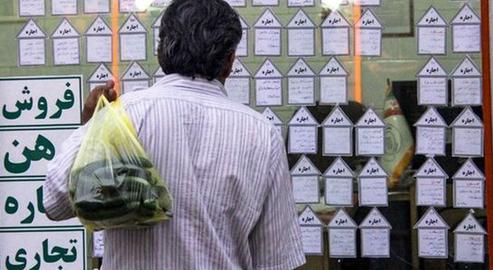As the price of housing continues to soar, Tehran residents face further economic crisis, and Iran's wider society will also bear the brunt.
The average price for one square meter of residential space in Tehran has shot past 17 million tomans or US$1,134. Considering that the average monthly income of an Iranian household is somewhere around $250, this is an unmitigated disaster and Iranian society will be forced to bear the consequences for many years to come.
A comparison of average housing prices over the last two months shows that, within one month, the price of a residential unit rose by more than 1.5 million tomans ($100), or around 10 percent per square meter. Compared to the same time last year, the price has increased by more than 36 percent. At that time, a square meter of a residential unit in the capital sold for 12.7 million tomans ($847), meaning that if an individual or family wanted to buy a home or an apartment last year but was for whatever reason unable to, this year they will be faced with a price of 4.35 million tomans ($287) per square meter for the same property, an impossible proposition for an average family.
What is the “Hope for Home Ownership Waiting Period” Index?
This index estimates how many years it will take a family to buy a home based on calculations for the average family income and the average price of housing.
To arrive at a result, the index assumes that a household allocates one-third of its income to housing. Therefore, by dividing the average price of housing by one-third of the average family income, it is possible to estimate how long an average family will wait to own a home in Iran.
For instance, based on statistics published by the Ministry of Roads and Urban Development, the average price of a housing unit in Iran in 2016 was around 192 million tomans ($12,800) and the average annual family income in the same year amounted to approximately 32 million tomans ($2,134). Dividing 192 million by one-third of 32 million results in the conclusion that, in 2016, the waiting period for homeownership in Iran was about 18 years. In 2000, this period was 12 years and by 2009 it had increased to 23 years.
It is important to highlight two points about these statistics. The first is that they stop at 2016; secondly, the calculations provided by the Ministry of Roads and Urban Development and used to determine an average housing price are defective because they only take into account prices in provincial capitals, whereas the volume of housing transactions vary in different provinces. For instance, the number of housing transactions in Tehran is several times greater than the number in Birjand, the capital of South Khorasan in eastern Iran. So to arrive at average housing prices, it is necessary to use either weighted averages or to calculate the “hope for homeownership wait period” index separately for each city.
Home Ownership Hope Index for Tehran
Official statistics reveal that about half of housing units sold and bought in Tehran are between 50 and 90 square meters. If it is assumed that an average housing unit in Tehran is 70 square meters, this unit costs 1.195 billion tomans ($79,667) in May. But just one month earlier, this housing unit could have been purchased for less than 1.1 billion tomans. In other words, if a prospective homeowner did not buy the house in April, they would have to dish out 95 million tomans ($7,340) more in May.
A year ago, in May 2019, the price of the same housing unit was less than 890 million tomans ($59,334) and a year earlier, a 70-square-meter housing unit cost 418 million tomans ($27,867) or less. So, if a person could by a 70-square-meter unit of accommodation for 418 million tomans in May 2018, in May 2020 a further 777 million tomans ($51,800) would be required to buy the same place.
Has the average income increased accordingly? According to the Statistical Center of Iran, the average annual income of an urban household in Tehran province in 2018 was 64 million tomans ($4,267). Therefore, the waiting period for homeownership was 20 years in Tehran.
The figures for current average household annual incomes have yet to be published but, if we assume that the income has kept pace with a 35-percent inflation rate, it was 86 million tomans ($5,734) in 2019 and now stands at 116 million tomans ($7,734). According to this assumption, the waiting period for home ownership is now 31 years, meaning that if a family has a revenue of 10 million tomans ($667) per month and sets aside 40 million tomans ($2,667) each year for housing, and even if it can be assumed that the prices remain stable — a very big if — the family would not be able to afford to buy a 70-square-meter place to live for another 30 years.
visit the accountability section
In this section of Iran Wire, you can contact the officials and launch your campaign for various problems

























comments